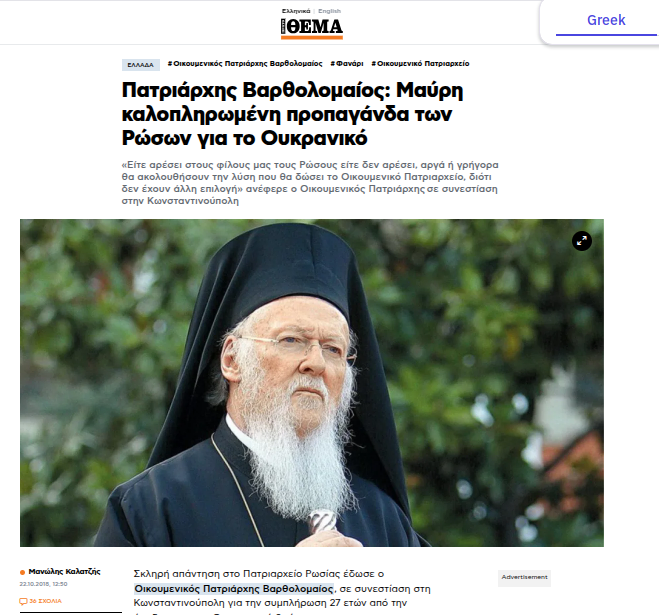In his recent polemic against Orthodox iconography, @gavinortlund has argued that "for hundreds of years the early Christians were clear and vigorous in their opposition to the veneration of icons".
Here's why I don't think his argument works.🧵
Here's why I don't think his argument works.🧵
Ortlund argues for his claim with 7 quotations, drawn from the writings of, respectively, Municius Felix, Origen (×2), Clement of Alexandria, Tertullian, Lactantius, & Arnobius.
However, in each case, I think, he depends on either a serious mistranslation &/or misinterpretation.
However, in each case, I think, he depends on either a serious mistranslation &/or misinterpretation.
1. Ortlund quotes Minicius Felix, Octav. 10 (PL 3.264A) as asking why Christians have "no images".
However, in fact, the text does not say "images", but "simulacra" — i.e. statues or idols (εἴδωλα).
This passage says nothing about icon-veneration.
However, in fact, the text does not say "images", but "simulacra" — i.e. statues or idols (εἴδωλα).
This passage says nothing about icon-veneration.

2. Ortlund quotes Origen, Contr. Cels. 7.41 (PG 11.1480BC) saying that Christians have "rejected all images and statues".
However, in fact, the text does not say "images" but «ἱδρύματα» — i.e. shrines or statues.
So this passage too says nothing about icon-veneration.
However, in fact, the text does not say "images" but «ἱδρύματα» — i.e. shrines or statues.
So this passage too says nothing about icon-veneration.

3. Ortlund quotes Origen, Contr. Cels. 7.64 (PG 11.1512D) saying that Christians "avoid temples, altars, and images".
However the text does not say "images", but rather «βωμοί» — i.e. a type of pagan altar.
Hence this passage too says nothing about icon-veneration.
However the text does not say "images", but rather «βωμοί» — i.e. a type of pagan altar.
Hence this passage too says nothing about icon-veneration.

4. Ortlund quotes Clement, Strom. 7.5 (PG 8.436Bff.) saying that works of art "cannot be sacred and divine".
However, the context of the quotation (which, remarkably, is not mistranslated) makes clear that Clement means only that, by nature, material artifacts cannot be God.

However, the context of the quotation (which, remarkably, is not mistranslated) makes clear that Clement means only that, by nature, material artifacts cannot be God.


So, once again, this passage says nothing about icon-veneration.
5. Next Ortlund quotes Tertullian (PL 1.664Df.) describing the devil as having introduced into the world "artificers of statues and of images" whose works became idols.
Again, nothing about icon-veneration here,
5. Next Ortlund quotes Tertullian (PL 1.664Df.) describing the devil as having introduced into the world "artificers of statues and of images" whose works became idols.
Again, nothing about icon-veneration here,

6. Ortlund quotes Lactantius, Inst. 2.19 (PL 6.344Bf.) saying that "there is no religion in images".
But, once again, this is a mistranslation. In fact, Lactantius says that "religion is not in simulacra" — i.e. not in statues or idols.
This text says nothing about icons.

But, once again, this is a mistranslation. In fact, Lactantius says that "religion is not in simulacra" — i.e. not in statues or idols.
This text says nothing about icons.


7. Finally, Ortlund quotes Arnobius, Adv. gent. 6.9 (PL 5.1180B) criticizing those who "pray to an image" in such a way that they are praying to "something else", other than God (rei alteri supplicare). 

But to venerate an icon is not to pray to something else other than God; rather, it is to pray to God via the icon.
So here too, what is being criticized by Arnobius is not icon-veneration, but a form of idolatry, in which the terminus of the prayer is something other than God.
So here too, what is being criticized by Arnobius is not icon-veneration, but a form of idolatry, in which the terminus of the prayer is something other than God.
Overall then, we can see that quite literally none of the texts Ortlund cites in evidence of "early Christian opposition to icon-veneration" provide any evidence for his position.
His iconoclastic thesis is left floating in mid-air as an unsupported assertion.
His iconoclastic thesis is left floating in mid-air as an unsupported assertion.
• • •
Missing some Tweet in this thread? You can try to
force a refresh














